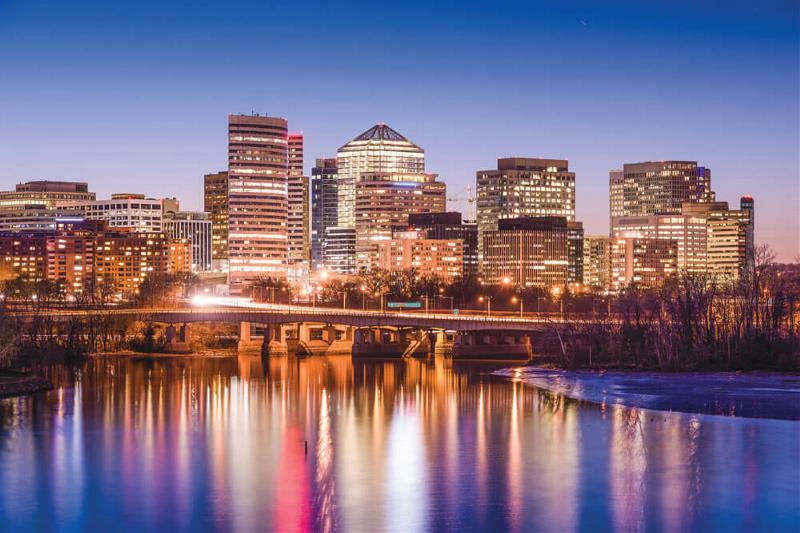Railroad Switching Yard on Banks of the Potomac: Re-emerging as “Gateway to Alexandria”
By
Frank Dillow

NEW PROJECTS COMPRISE WAVE OF THE FUTURE
Nestled between the George Washington Parkway and the Potomac River, spanning more than 300 acres from Reagan National Airport to the City of Alexandria, Potomac Yard and the adjacent Oakville Triangle will soon emerge as the latest of Northern Virginia’s growing urban centers.
Long-term plans call for Potomac Yard eventually to include 7.5 million square feet of mixed use development – office, retail, hotel and residential anchored by a new Metro station, on what was once one of the busiest railroad switching yards on the Eastern Seaboard.
The Potomac Yard was developed in the early 1800s as a transportation hub managing canal, and later rail transportation between Alexandria, Georgetown and ultimately Washington, D.C. By the early 1900s the Potomac Yard became a railroad switching yard, processing thousands of cars daily and attracting workers who settled in the nearby Del Ray and St. Elmo communities, now a part of Alexandria. During the early days of World War II, National Airport was opened on the yard’s northern boundary.
The switching yard closed some thirty years ago, leaving behind a toxic waste site contaminated by heavy metal and diesel fuel. The Environmental Protection Agency (EPA) declared the area a Superfund site and in 1995 approved a cleanup plan, which was declared completed in 1998.
While the cleanup was underway, several development plans were being considered, including using the site for the construction of a new stadium for Washington’s professional football team. By 1997 the Potomac Yard Center, a 600,000 square-foot “big box” retail strip mall was completed.
Shortly thereafter two towers, Potomac Yard One and Two, accounting for nearly one-half million square feet of office space, were added to area, now house headquarters operations for various EPA divisions. Recently, the Institute for Defense Analyses announced they will be departing the transportation-congested Mark Center on I-395 at Seminary Road and relocating to a 370,000 square-foot Potomac Yard site.
With recent approvals for future enhancements, including a $268 million station on Metro’s Blue and Yellow lines, Alexandria Economic Development Partnership (AEDP) planners envision a transformation of the land parcel overlooking the Potomac River into a “modern mixed use, transit-oriented community,” and the scenic “natural gateway” into Alexandria. They predict its development will take advantage of the area’s unique strengths including its central location, history and rich transportation alternatives. In addition to the nearby George Washington Parkway and Route 1 Highway, the parcel has access to the national airport, the CSX rail lines running through it -- also used by the Virginia Railway Express (VRE) commuter line -- and the planned Metro station.
Arlington County and the City of Alexandria have recently co-operated with the Metro bus service to implement the metropolitan area’s first “express transit way.” It uses dedicated transit lanes, bus stops and more frequent service to link Crystal City through Potomac Yard to the Braddock Road Metro station four and a half miles away.
During the past year the City of Alexandria has also built a multi-use paved trail from Potomac Yard to the Braddock Road Metro station, as part of a 24-acre park providing residents with a bike and pedestrian route south to Old Town. As the Potomac Yard redevelopment plan continues to evolve, the city plans to extend the trail north to Four Mile Run and Crystal City in Arlington County.
In the first phase of the North Potomac Yard Small Area Plan, the JBG Co. will overhaul the existing 600,000 square-foot North Potomac Yard shopping center, replacing the existing multiplex theater and surrounding parking lot with a 1.2 million square-foot mixed use development. The plan includes 732 residential units, nearly 300,000 square feet of retail and slightly more than 115,000 square feet of office, or possibly a 120-room hotel. According to the plan, the initial phase will be completed by 2020 when the new Metro station opens.
In addition, the proposal includes a dedicated school site, along with a four-acre extension of the existing Potomac Yard Park, which will eventually stretch from the new Metro station north to Four Mile Run. Current plans also envision redeveloping the “big box” mall as the existing tenant leases expire over the next decades. Also on the City’s drawing boards are plans to redevelop the South Potomac Yard.
At the same time, across Route One a quarter mile away from the proposed Potomac Yard Metro Station, another 16-acre site known as Oakville Triangle will have 1.5 million square feet of mixed use development including apartments, condos, office and retail. According to plans recently approved by the Alexandria City Council, the first phase is expected to be completed by the summer of 2019. The development will feature pedestrian and bike transportation access into a proposed central plaza.
The new Metro station will be located midway between the existing Reagan National Airport and Braddock Road stations near the current Potomac Yard shopping center. Planners predict it will bring 26,000 new jobs, 21,000 new homes and add up to $4.5 billion in new tax revenues to the City in the next 20 to 30 years.
Included in the plans for the new station is an agreement between the City of Alexandria and the National Park Service, for the City to acquire a 7,000 square-foot easement from the adjoining George Washington Parkway. In return, the City will spend $12 million improving the Mt. Vernon Trail and Dangerfield Island, and will transfer 13.5 acres of parkland to NPS.
As the area continues to transform, Potomac Yard will become yet another prime example of the close-in, transit-oriented and mixed-use suburbs described by the Urban Land Institute as the “wave of the future” in its 2016 report on emerging trends in real estate.